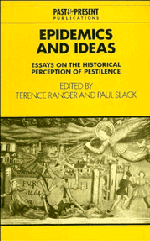Book contents
- Frontmatter
- Contents
- Contributors
- Preface
- 1 Introduction
- 2 Epidemic, ideas and classical Athenian society
- 3 Disease, dragons and saints: the management of epidemics in the Dark Ages
- 4 Epidemic disease in formal and popular thought in early Islamic Society
- 5 Plague and perceptions of the poor in early modern Italy
- 6 Dearth, dirt and fever epidemics: rewriting the history of British ‘public health’, 1780–1850
- 7 Epidemics and revolutions: cholera in nineteenth-century Europe
- 8 Hawaiian depopulation as a model for the Amerindian experience
- 9 Plague panic and epidemic politics in India, 1896–1914
- 10 Plagues of beasts and men; prophetic responses to epidemic in eastern and southern Africa
- 11 Syphilis in colonial East and Central Africa: the social construction of an epidemic
- 12 The early years of AIDS in the United Kingdom 1981–6: historical perspectives
- Index
- Past and Present Publications
11 - Syphilis in colonial East and Central Africa: the social construction of an epidemic
Published online by Cambridge University Press: 05 August 2011
- Frontmatter
- Contents
- Contributors
- Preface
- 1 Introduction
- 2 Epidemic, ideas and classical Athenian society
- 3 Disease, dragons and saints: the management of epidemics in the Dark Ages
- 4 Epidemic disease in formal and popular thought in early Islamic Society
- 5 Plague and perceptions of the poor in early modern Italy
- 6 Dearth, dirt and fever epidemics: rewriting the history of British ‘public health’, 1780–1850
- 7 Epidemics and revolutions: cholera in nineteenth-century Europe
- 8 Hawaiian depopulation as a model for the Amerindian experience
- 9 Plague panic and epidemic politics in India, 1896–1914
- 10 Plagues of beasts and men; prophetic responses to epidemic in eastern and southern Africa
- 11 Syphilis in colonial East and Central Africa: the social construction of an epidemic
- 12 The early years of AIDS in the United Kingdom 1981–6: historical perspectives
- Index
- Past and Present Publications
Summary
THE FIRST DEFINITIONS OF THE EPIDEMIC
In 1908 a debate unfolded on the pages of The Lancet and of the British Medical Journal over the causes of an apparently alarming ‘epidemic’ of syphilis which had broken out in the Uganda Protectorate. In both journals the debate began with an account of a paper recently presented by an officer of the Royal Army Medical Corps, Colonel Lambkin, entitled ‘An Outbreak of Syphilis on Virgin Soil’. Lambkin, known for his work on sleeping sickness in Uganda, had described to his medical audience a situation in which syphilis was so widely spread that an estimated 80 per cent of the population of Buganda was infected, and in which a resulting infant mortality rate of 50 to 60 per cent threatened the very survival of what he referred to as the ‘race’. The causes of this outbreak, according to Lambkin, were three: the introduction of Christianity, the abolition of previously severe punishments for sexual offences and the opening up of the country to traders from the East. In his analysis, Lambkin laid great stress on the notion of Uganda as a ‘virgin soil’ in which an innocent and unsuspecting population had been exposed to a new and devastating disease. But the very vulnerability of the Bagandan people had, according to Lambkin, been created by the disintegration of their traditional social and political system brought about primarily by the introduction of Christianity.
- Type
- Chapter
- Information
- Epidemics and IdeasEssays on the Historical Perception of Pestilence, pp. 269 - 302Publisher: Cambridge University PressPrint publication year: 1992
- 41
- Cited by



